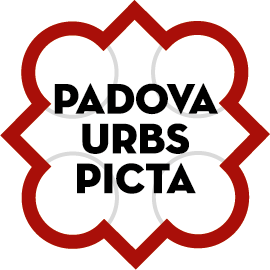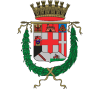This itinerary takes you through the eastern area of the city centre, which was once the centre of commercial activities. It extends from the Naviglio Interno (inner city canal) to the canals of Portello, which was where merchandise arrived by boat from Venice to then be distributed around the city. However, it also includes one of the veritable masterpieces of world art, which by itself is enough to make Padua worth visiting: the Scrovegni Chapel, with its wonderful Giotto frescoes, and the museum complex of the Musei Civici Eremitani.
Starting from Via Porciglia, you stroll through the Arena Gardens to Piazza Garibaldi at the opposite end of the main avenue. Turning left into Via Garibaldi, you have on your right Palazzo Zuckermann (position on the map: 25), which is home to the Bottacin Museum and the Museum of Applied Arts, and to your left the ruins of the Roman Arena, beyond which is the Eremitani Museum Complex, which includes the Scrovegni Chapel (map: 26) whose Giotto frescoes are one of the highest expressions of Late Medieval Art. If you follow the perimeter wall around the Arena, you come to Piazza Eremitani, in which stands the Church of the Eremitani (map: 28), which contains frescoes by Mantegna; to the left of the church are the Eremitani Museum Complex (map: 27) and the Scrovegni Chapel. The delicate state of the chapel and the frescoes means that visits are only for small groups at specific times, so you have to book beforehand. However, you certainly should not come to Padua without going to see frescoes that mark a revolutionary turning-point in our understanding of what art is.
From the Eremitani to Santa Sofia
At the end of your visit to the museum and the chapel, return to Piazza Eremitani and then take Via Eremitani, which runs between two buildings that house the Cassa di Risparmio Savings Bank. Continue up this street to its junction with Via Altinate. Here, turn left into one of the oldest and most important roads into the city: it led to the town of Altino, which was a major staging-point on the road to Aquileia. Off this street, to the left, runs Via Cassan, which is the location of the Tribunale Vecchio [Old Courthouse] and the church of San Gaetano (map: 32). At the end of Via Altinate, on the right, is the church of Santa Sofia (map: 33); the oldest church in the city, this stands on the remains of a Roman temple.
Moving through Borgo Portello with Indiana Jones
If you cross Via Morgagni, you then continue straight on into Via Belzoni; this is named after a man who might be described as the ‘true Indiana Jones’ – Giovanbattista Belzoni, an explorer and Egyptologist who was also an inventor and someone who was definitely ‘larger than life’. This takes us into the Portello district, so named because it was home to the most important port for river trade with Venice; the ancient role of this place within the city is reflected in the fact that the Paduan dialect spoken here (‘portellato’) is said to be the most authentic of all. Now the entire area is largely occupied by university facilities, as can be seen by the fact that Palazzo Querini-Mocenigo-Nievo (map: 34), which was the birthplace of the novelist Ippolito Nievo, is now a student hall of residence. At the end of Via Belzoni, on the left, is Piazza Portello, at the end of which you can see Porta Portello (map: 35), beyond which is the bridge you will now cross. On the other side of the canal, to the right, is the staircase that was once used when unloading boats; nowadays it is a splendid place to watch the waters flow past on a star-lit night. This is also the starting-point for a number of boat trips that take visitors through the city’s old waterways or along the routes that led to Venice.
If here you turn left into Via Colombo, you can view the sixteenth-century city walls and a canal which is a reminder of the other beauties of Padua that are covered in the other itineraries. Continuing along Via Colomba, you come to Via Trieste, which is the location of the ex-Gasometer car park. From here you can easily walk to the train station (turn right into Via Gozzi) or use one of the buses, which will drop you off opposite the bus station.












